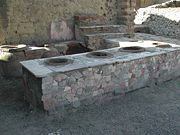
Thermopolium
Encyclopedia

Ancient Rome
Ancient Rome was a thriving civilization that grew on the Italian Peninsula as early as the 8th century BC. Located along the Mediterranean Sea and centered on the city of Rome, it expanded to one of the largest empires in the ancient world....
, a thermopolium (plural thermopolia) was a commercial establishment where it was possible to purchase ready-to-eat food. The forerunner of today's restaurant
Restaurant
A restaurant is an establishment which prepares and serves food and drink to customers in return for money. Meals are generally served and eaten on premises, but many restaurants also offer take-out and food delivery services...
, the items served at the thermopolia are sometimes compared to modern fast-food. These places were mainly used by the poor or those who simply could not afford a private kitchen, sometimes leading them to be scorned by the upper class.
Design
A typical thermopolium would consist of a small room with a distinctive masonryMasonry
Masonry is the building of structures from individual units laid in and bound together by mortar; the term masonry can also refer to the units themselves. The common materials of masonry construction are brick, stone, marble, granite, travertine, limestone; concrete block, glass block, stucco, and...
counter in the front. Embedded in this counter were earthenware jars (called dolia
Dolium
A dolium is a large earthenware vase or container used in ancient Roman times for storage or transportation of goods.-Description:...
) used to store dried food like nuts (hot food would have required the dolia to be cleaned out after use, and because they are embedded in the counter, it is believed that they were not used to store hot food, but rather dried food where cleaning wouldn't be necessary). Fancier thermopolia would also be decorated with fresco
Fresco
Fresco is any of several related mural painting types, executed on plaster on walls or ceilings. The word fresco comes from the Greek word affresca which derives from the Latin word for "fresh". Frescoes first developed in the ancient world and continued to be popular through the Renaissance...
es.
Well-preserved ruins of thermopolia can be seen in Pompeii
Pompeii
The city of Pompeii is a partially buried Roman town-city near modern Naples in the Italian region of Campania, in the territory of the comune of Pompei. Along with Herculaneum, Pompeii was destroyed and completely buried during a long catastrophic eruption of the volcano Mount Vesuvius spanning...
and Herculanum.
Thermopolium of Asellina
The Thermopolium of Asellina is one of the most complete examples of a thermopolium in PompeiiPompeii
The city of Pompeii is a partially buried Roman town-city near modern Naples in the Italian region of Campania, in the territory of the comune of Pompei. Along with Herculaneum, Pompeii was destroyed and completely buried during a long catastrophic eruption of the volcano Mount Vesuvius spanning...
. Complete jugs and dishes were found on the counter, as well as a kettle filled with water. The ground floor in the thermapolia Aselina was used for people to eat and drink, and some stairs led guest rooms on the second floor.
It had a typical structure consisting of a doorway open to the street, a counter with holes (dolia) in it for food or wine. It had shrines for the Lares (household gods) , Mercury (god of commerce) and Dionysus (god of Wine) , as these were the most important gods for this occupation. Upstairs, there were guest rooms as well, so this may have also been used as an Inn, however, many think that this may have been a brothel due to the names of many women written on one of the walls of the Thermopolium.

Further reading
- Ellis, Steven J. R. (2004): "The Distribution of Bars at Pompeii: Archaeological, Spatial and Viewshed Analyses", Journal of Roman Archaeology, Vol. 17, pp. 371–384

